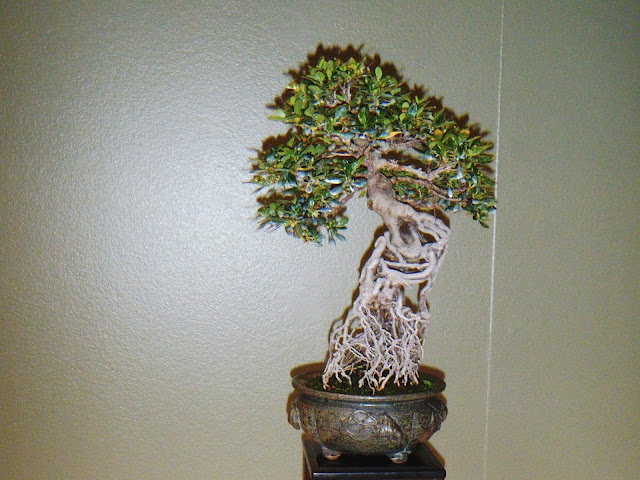The Fall Show that I invited all and sundry to visit, held last Saturday, went very well. We had a very good turnout, due in part to the fact that another Japanese-themed event was held in another part of the Foellinger-Freimann Conservatory that same day. Undoubtedly some people on their way to the "Japanese Family Event" stopped on the way to take a look at our bonsai, and some who came to our show then decided to proceed down the hall to the Japanese Family Event. Win-win!
As I've mentioned before, I'm not nearly the almost-instinctive photographer my wife is. On top of that, my camera's battery died early on. Still, I did get a few pictures worth posting.
| Ed discussing a point with one of our newer members, while Becky takes a turn at the sale table. |
The next two pictures were taken with my smartphone camera after my regular camera was electrically dead. Please forgive the picture quality.
 |
| A yamadori ponderosa (Pinus ponderosa,) and a crepe myrtle (Lagerstroemia indica) in eye-catching bloom. |
As at the last several shows, I spent most of the time at the work table in the Conservatory lobby. Any work I got done was, in a sense, a bonus: my primary reason for being there was to pique visitors' curiosity and encourage them to stop at the display. That often involved answering questions about bonsai, which I am never loath to do. (Just ask my lovely wife.) One man in particular, altho he has no bonsai experience, had a number of very perceptive questions.
| My demo tree, an Austrian pine (a.k.a. European black pine,) before work started. Pinus nigra. |
| The demo tree after the day's work. As one wit said, "If you're not appalled at what you've done, you haven't pruned enough!" |
I've been shaping this tree a little at a time over a number of years, aiming for a semi-cascade (one of my favorite styles) without constraining its own quirks too much. This season it was allowed to grow wild until the Show. In this work session I cut it back to encourage compactness and ramification, thinned the foliage, and repositioned the first branch and the "lion's tail." Next spring it will be repotted and then allowed to grow untouched for the rest of the season. Major wiring will follow in 2018, and I hope to have it into a display pot within a couple of years after that.
I bought this and a few other Austrian pines when I was looking for a tough, esthetically pleasing and readily available species to recommend to bonsai beginners in this part of the USA. I have since decided that yews fit my criteria better, and have switched much of my focus to them. (See this page to read more.) But I'm still working with this Austrian and a few others, just to see how they'll turn out. ☺
:-) :-) :-)


